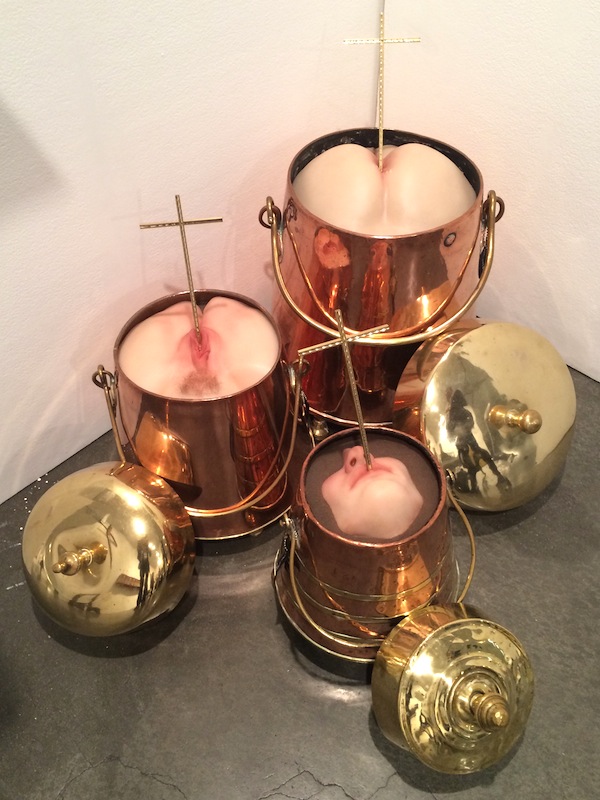
“There’s been a lot of interest in the digital works—surprise surprise,” the Fine Art Society‘s gallery manager Rob Owen told artnet News two hours into Thursday’s VIP preview of the inaugural Silicon Valley Contemporary (SVC) fair in San Jose. The London gallery, like many of the 51 other participants, features new media works amid its offerings—in this case, a set of Rob and Nick Carter‘s digital video still lifes, each priced at $150,000—in hopes of appealing to the fair’s target demographic, the Silicon Valley tech industry.
KM Fine Arts is accepting payment in bitcoin at the Silicon Valley Contemporary art fair.
Photo: Benjamin Sutton.
As if to further entice the tech set, Chicago–Los Angeles gallery KM Fine Arts is prominently broadcasting its acceptance of the digital currency bitcoin as payment, and the scheme seems to be working. Within a half-hour of the preview starting gallery director Ana M. Holinger reported that the gallery was processing a bitcoin payment for Dana Louise Kirkpatrick‘s large-scale painting Off Limits But Blessed by the Fed (2014), the lower-right-hand corner of which happens to include a rendering of the controversial currency’s logo.
Works by Ben Jones in the ACE Gallery booth at Silicon Valley Contemporary.
Photo: Benjamin Sutton.
Wandering the aisles in hall two of the expansive San Jose Convention Center, quite a few dealers seem to have brought works like the Carter brothers’ that combine old and new media. In SVC’s biggest booth, which belongs to Los Angeles’s ACE Gallery, amid a selection heavy on street art, an alcove contains three bold and fun works by Ben Jones: a pair of neon-hued sculptures of twisted ladders flanking one his large-scale video paintings, which combines an eight-foot-wide canvas of a video game-evoking landscape with a projection of abstract patterns and stripes.
Sanaz Mazinani, Howitzer and Fireworks (2014).
Photo: Benjamin Sutton.
An even more compelling—and politically charged—work combining high-tech and traditional media can be found in Stephen Bulger Gallery‘s booth. The Toronto dealer is showing works by the Iranian-Canadian artist Sanaz Mazinani that turn news media images of conflict—the Occupy demonstrations in Oakland, the protests in Cairo’s Tahrir Square, and a US Army ceremony in 2005—into quasi-abstract mosaics. Howitzer and Fireworks (2014), a concave photo-mosaic in the shape of an octagon and measuring five feet in diameter, is going for $7,500.
KATSU’s Drone Paintings in The Hole’s booth.
Photo: Benjamin Sutton.
Other dealers are showing sculptures and paintings that engage with digital technologies in other ways, either as subject matter or as a component of their studio practice. New York gallery The Hole has an entire booth of paintings, an armchair, a carpet, and a TV stand that were spray-painted by a drone aircraft piloted by the street artist KATSU. Though the sparsely and pleasantly sprayed canvases evoke a gentler Jackson Pollock, a video playing in the booth reveals the works’ very high-tech production process. The pieces in the booth are all priced between $3,000 and $10,000.
Mark Flood’s painting of the Apple logo in UNTITLED’s booth.
Photo: Benjamin Sutton.
Another Lower East Side gallery is offering paintings about technology: UNTITLED‘s booth features a series of Mark Flood canvases emblazoned with pixelated, blurred, and otherwise distorted tech company logos. In addition to barely-legible purple-on-black renderings of the Atari and SEGA logos, Flood is paying homage to one of Silicon Valley’s giants, Apple, with a rendering of its ubiquitous icon as a garish QR code. Priced at $43,000, it should fall well within an Apple executive’s budget.
Similarly depicting high-tech things in a very tactile, old-media manner is former Warhol Factory superstar Ultra Violet, who is riffing on her own series of Self Portraits with the new etched mirror piece Selfie (2014). That piece, priced at $6,000 and available in an edition of nine from New York’s Dillon Gallery, was unsurprisingly popular with the Instagram set during the VIP preview.
Visitors in the aisles at the inaugural Silicon Valley Contemporary fair.
Photo: Benjamin Sutton.
Other dealers eschewed the tech trend and are betting on the appeal of beautiful or arresting objects. San Francisco local the McLoughlin Gallery falls squarely into this category, particularly with the works of Dutch artist Arnix Wilnoudt, who sculptures combine creepily realistic silicone body parts placed inside antique copper and brass buckets and adorned with strategically placed crucifixes. “When we were curating the booth, the organizers of the fair told us: ‘Bring the most provocative works you have,'” recalled gallery associate Chase Dougherty, “and we said, ‘Okay, you asked for it.'” Wilnoudt’s set of potted body parts, The Holy Trinity (2014), is priced at $19,500.
Desire Obtain Cherish, Text Bubbles (2014), in the UNIX Gallery booth.
Photo: Benjamin Sutton.
While it’s too early to tell what the tech industry’s collectors-in-waiting will buy—it may be a couple of years before they’re ready to put down $150,000 in bitcoins for a digital still life—the mood on Thursday night was very upbeat, curious, and optimistic. Dealers aren’t expecting immediate returns, just trying to figure out what type of work will help them get a foothold in Silicon Valley.
Sanford Biggers, Quilt #7.
Photo: Benjamin Sutton.
“I wanted to bring a variety of things because I didn’t want to make any assumptions,” said Miami dealer David Castillo, whose booth features a very strong set of resolutely old media works, including a superb quilt by Sanford Biggers. “Maybe people who are dealing with technology every day in their jobs aren’t interested in technological art,” Castillo added.
Silicon Valley Contemporary continues at the San Jose Convention Center through April 13.